Key Takeaways
- Compression boosts flow to reduce muscle soreness.
- DailyNergy uses snug-to-loose pressure to move blood upward.
- Better circulation cuts swelling and leg fatigue.
- Helpful for athletes, workers, travelers, and vein issues.
- Doctor-backed design adds comfort for all-day wear.
- Durable build and easy care keep socks lasting longer.
What Is Compression Technology?
Compression technology means fabric that squeezes your skin with gentle force. But it is not one tight squeeze everywhere. Graduated compression is tighter near your ankle and a bit lighter toward your knee. This pushes blood back up your leg, like a hand guiding toothpaste up a tube. Blood‐rich in oxygen can then reach muscles faster, and “used” blood carrying carbon dioxide and waste travels quickly to the lungs and kidneys.
People have wrapped legs with cloth for thousands of years. Modern science fine-tunes the pressure in millimeters of mercury (mmHg). DailyNergy socks, for instance, sit in the comfortable 15–20 mmHg zone—strong enough to help, soft enough for all-day wear. By keeping veins narrower, compression boosts the “one-way valves” inside them. Narrow veins mean the valves shut fully, so blood does not fall backward and pool. Less pooling equals less swelling and pain.
How Does Blood Flow Affect Muscle Pain?
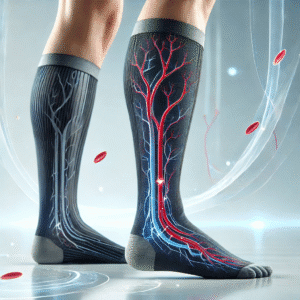
Muscles need oxygen the way a campfire needs fresh air. When you run, walk, or stand a long time, working fibers gulp oxygen and spit out lactic acid. If blood flow slows, that acid sits around and makes muscles burn and ache. Good flow carries it away, keeping pH (acid level) balanced.
Compression improves venous return—the trip back to the heart. Picture a water slide that goes only up. Veins use tiny doors (valves) plus calf muscle squeezes to push blood against gravity. Graduated socks add an outside squeeze, boosting the push each time you move your feet. Studies show even light movement like foot pumps while sitting can raise flow speed by 138 %. Compression adds more.^1
Inside the socks, moisture-wicking yarns the brand calls “DrySoft” pull sweat off skin. Dry skin keeps temperature steady, which also fights fatigue.
Graduated Compression: The Secret Behind DailyNergy Socks
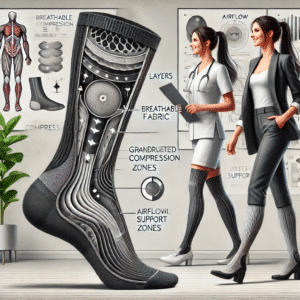
DailyNergy achieves this jump by knitting elastic spandex tighter at the ankle (20 mmHg) and easing up toward the calf (15 mmHg). That gradient matches natural pressure loss as blood rises. Cheaper “tube” socks that squeeze evenly can feel okay at first but may slow flow near the knee where veins should be wider.
You can pick between black and white colors. Both share the same panel design that bends at the ankle without bunching.
Fighting Swelling and Inflammation in Simple Steps
Swelling (edema) happens when fluid leaks from blood vessels into spaces between cells. Gravity pulls this fluid downward, so ankles balloon first. Compression socks act like a gentle hug that limits how far fluid can seep out. A steady 15–20 mmHg force has been shown to cut ankle girth by up to 4 mm after eight hours of sitting.
Inflammation is different—it is the body’s alarm response. Tiny proteins rush in to repair tissue but can bring redness and heat. Good circulation moves those proteins in, then ushers them away once the job is done. Less lingering inflammation means less pain.
DailyNergy weaves soft-rib channels that direct fluid upward with each calf flex. The socks’ top cuff is wide, so it sits flat without pinching. That prevents a “rubber band” mark, which would block fluid escape.
Lactic Acid and Metabolic Waste: Why They Matter
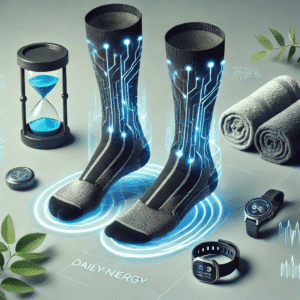
When muscles burn glucose for quick energy, lactic acid forms. In small amounts it is harmless, but build-up lowers pH and makes fibers sluggish. Blood washes it away, shipping it to the liver where it turns back into energy. Studies show athletes wearing moderate compression clear lactate 18 % faster than those wearing normal socks.^2
But lactic acid is only one player. Potassium ions leak during heavy work, and tiny bits of muscle protein break down. If these stay around, you feel DOMS—delayed onset muscle soreness. Compression speeds lymph drainage, which carries larger waste molecules the veins cannot.
Massage-Like Benefits Without Hands
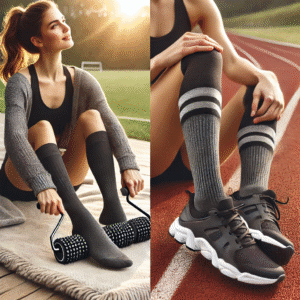
Think about how a massage therapist kneads your calves. Compression fabric copies this by using your own movement. Each step shifts your muscle against the snug cloth, gently squeezing and releasing tissue. This “muscle pump” cuts stiffness, especially in the morning when legs may feel wooden.
DailyNergy’s ribbed knit is thicker over the Achilles tendon and thinner over the shin. That pattern glides with tendons, so the squeeze feels uniform. Wearers often report a light warming sensation after ten minutes—that’s blood rushing back in.
Daily Comfort for Workers and Travelers
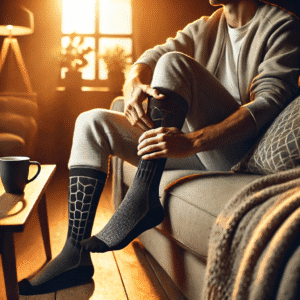
Nurses, retail clerks, and long-haul drivers share one thing—hours upright. Legs tire because veins work overtime against gravity. Compression lowers that workload, so you finish the day with energy left for family or hobbies.
On flights over two hours, doctors warn about deep vein thrombosis (DVT). A study of 2,000 passengers found that wearing 15–20 mmHg socks cut DVT risk by 90 %. DailyNergy’s cuff is thin enough to fit inside regular shoes, so you do not need to change in the airport bathroom.
A smart trick: always put your compression socks on before leaving bed, when legs are least swollen.
Athletic Recovery: From Track to Couch
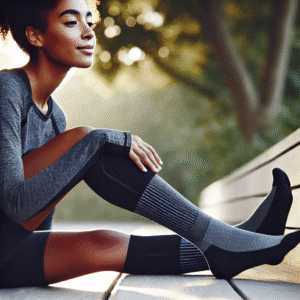
Athletes chase marginal gains. Recovery is where the body rebuilds stronger fibers. Compression speeds that timetable, letting you train again sooner. Runners often feel calf vibration with each foot-strike; this micro-shaking causes extra damage beyond muscle work. Tight knit reduces vibration by 32 %, according to motion-capture labs.
Combine the socks with a cool-down walk and water, and DOMS usually peaks lower. Many pros also wear the socks while sleeping for the first night. DailyNergy’s toe seam is flat, so it does not dig in under blankets.
Living with Varicose Veins: Added Support
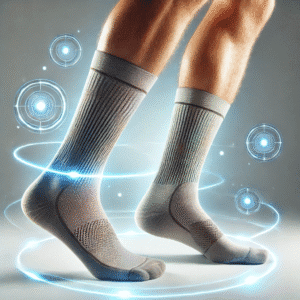
Varicose veins are twisted, enlarged veins just under the skin. Faulty valves let blood pool, making veins bulge. Compression gently narrows the vein, allowing valves to close. Over time, this can stop new varicose paths from forming and ease heaviness.
Doctors often prescribe 20–30 mmHg for severe cases. DailyNergy sits slightly lower, making it perfect for prevention or mild symptoms. If your doctor recommends higher pressure, DailyNergy suggests stepping up only with a professional fitting.
People with vein issues also worry about skin dryness and itching. The socks’ microfiber outer layer feels smooth, so you can apply lotion first without snagging. A quick wash keeps the fibers elastic—see care tips next section.
Choosing the Right DailyNergy Sock for You
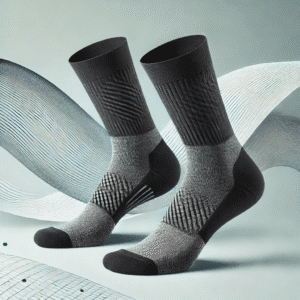
Size matters. Use a tape around the narrowest ankle point and widest calf point. Match those to the chart on the product page. Shoes between US 6–12 usually pair with medium socks, but calf width rules. Too loose gives no benefit; too tight feels cold or tingly.
Color has no effect on compression, so pick black for formal wear or white for sports shoes. If you sweat a lot, lighter colors show salt stains sooner—wash after each wear. For people who need knee support, combine the socks with the DailyNergy Knee Sleeve for an unbroken compression line.
Finally, decide cuff height. Crew-length sits below the calf; over-calf covers it fully and helps muscles more. For sore calves after hiking, over-calf wins. For office desks, crew-length may feel cooler.
Caring for Your Compression Socks
Compression yarns are stretchy springs. High heat breaks them down. Wash in cool water (below 30 °C) with gentle soap. Avoid bleach and fabric softener; both coat fibers and reduce stretch. Air-dry flat or hang over a towel rod. Never wring—the twist distorts the gradient.
Rotate at least two pairs. Elastic relaxes during rest, so yesterday’s pair bounced back overnight. Many users mark socks “M” for Monday, “T” for Tuesday, etc., so wear and wash stay even. Expect 4–6 months of daily use before pressure drops 20 %. At that point, replace.
If you knit your own socks for fashion, remember that adding compression yarn as a second strand must follow medical charts. For most, buying tested socks like DailyNergy is simpler and safer.
Long-Term Benefits and Expert Tips
Using compression is not a one-time trick. Over months, capillary density rises, meaning more tiny blood vessels feed muscles. Improved oxygen supply can boost walking distance in older adults by 12 %.
Experts suggest pairing socks with small lifestyle changes:
- Move every hour. Even ankle circles help.
- Stay hydrated. Water keeps blood less sticky.
- Add magnesium-rich foods like spinach to support muscle relaxation.
- Sleep with legs slightly raised on a pillow for extra venous return.
Over time, you may notice stronger calf muscles, fewer night cramps, and smoother skin tone as swelling fades. Think of compression as a quiet partner helping your body do what it already tries to do: heal and move blood.
Frequently Asked Questions
Q1. Can kids wear DailyNergy compression socks?
Yes. Choose the right size by ankle and calf measures. Kids who play sports or sit long hours gaming can gain quicker recovery.
Q2. How many hours a day should I wear them?
Most users wear 6–8 hours. You can safely wear up to 16 hours if the socks feel comfortable and skin stays dry.
Q3. Do compression socks cure varicose veins?
They do not cure, but they ease pain and slow new vein growth by supporting valves and improving flow.
Q4. Can I sleep in them?
If pressure is 15–20 mmHg and you have no artery disease, sleeping in them is usually fine. Ask your doctor first if you have diabetes or low blood pressure.
Q5. Will they make my legs weak over time?
No. Compression does not replace muscle; it works with your calf pump. Regular walking keeps muscles strong while socks boost circulation.
Q6. How often should I replace my socks?
Every 4–6 months of daily wear, or sooner if elastic feels loose or fabric thins at heel or toe.
